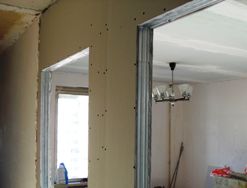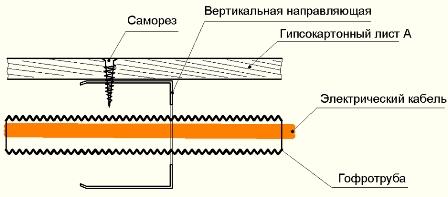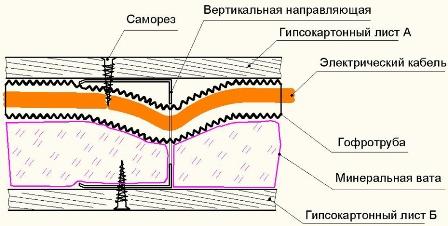Categories: Electrician Secrets, Electric installation work
Number of views: 73642
Comments on the article: 2
"Correct" wiring in plasterboard walls
 The article describes the installation sequence of the drywall partition, significantly reducing the cases of violation of the insulation of the cables laid in it.
The article describes the installation sequence of the drywall partition, significantly reducing the cases of violation of the insulation of the cables laid in it.
In recent years, the popularity of drywall partitions is growing. This is understandable: quickly, efficiently, conveniently. But how to protect the electric cables laid in such a partition, if each square meter of the partition contains up to hundreds of pointed screws (self-tapping screws) that can easily pierce any cable? Laying a cable along a specific route, for example, strictly 20 centimeters from the floor, helps to avoid misunderstandings, but more often this is not enough.
How to lay cables so that not a single screw breaks the insulation when screwing drywall sheets? A standard drywall partition consists of a frame assembled from galvanized steel profiles, which is sheathed with drywall sheets in one or two layers.
The interior space of the partition is filled with various soundproof materials. Mineral wool is often used to fill voids in such a partition. Sections of the drywall partition are shown in the figures.
Figure 1 shows the partition at the installation stage - only one side is sheathed and the cable is laid in the corrugated pipe. In the second figure, a fully mounted partition, where one self-tapping screw pierces the cable. Electricians say in these cases: "The installers of the partitions" found "our cable."
Fig. 1. Section of a drywall partition (top view). Only one sheet is sewn.
Fig. 2. Section of a drywall partition (top view)
The installation sequence of the drywall partition should be as follows:
1) Going frame.
2) One side of the partition is completely sheathed (in the figures sheet A). If it is supposed to sew drywall sheets in two layers, then it is necessary to mount both layers.
3) Electric cables are laid. Cables must be laid in corrugated pipehaving a fire safety certificate. A corrugated pipe with a cable is pulled through special holes in the vertical racks of the frame. If the corrugated pipe passes dangerously close to the tip of the self-tapping screw, it is moved or bit off by a self-tapping screw. With this approach, the probability of damage to the cables by self-tapping screws of the first sheathed side of the partition is already reduced to almost zero. It is possible to notice the potentially “dangerous” self-tapping screws when pulling the corrugated tubes in the cavity of the septum.
4) The voids of the partition are filled with soundproofing material.
5) The second side of the partition is sheathed. Cables turn out to be pressed to already sewn drywall sheets (sheet A) and screw-in screws (when mounting sheet B) will not break their insulation.
What can happen if you deviate from the described sequence of operations?
If the cables are laid immediately after the installation of the frame, then when sheathing the first side of the partition (in the figures of sheet A), some self-tapping screws may abut against the corrugated pipe. It can be extremely difficult to notice them, especially when several corrugated pipes are laid in parallel. When filling the voids of the septum with mineral wool and sewing drywall sheets on the second side of the septum (sheet B), the corrugated pipe is pressed to sheet A and the screws pierce the cables.
If the cables are laid after mounting one side of the partition (installation starts from sheet B in Figure 2) and filling the voids with mineral wool, then when screwing in the drywall sheets of the second side (sheet A), normal carelessness is enough to pierce the cable.Cable insulation is always violated by self-tapping screws of that side of the partition to which the corrugated pipe is pressed.
See also at bgv.electricianexp.com
:


